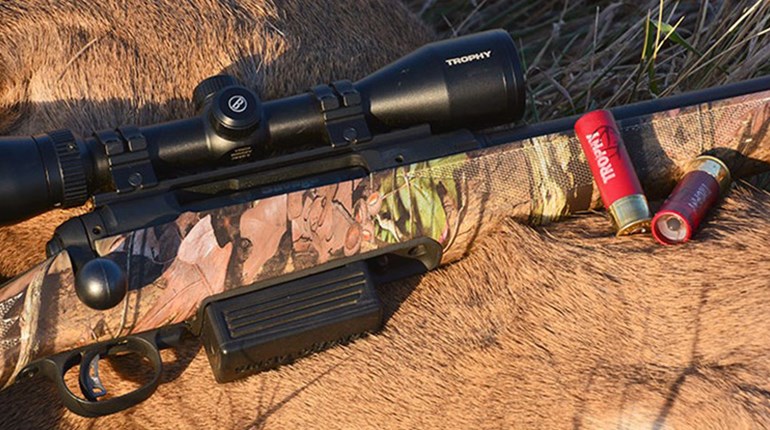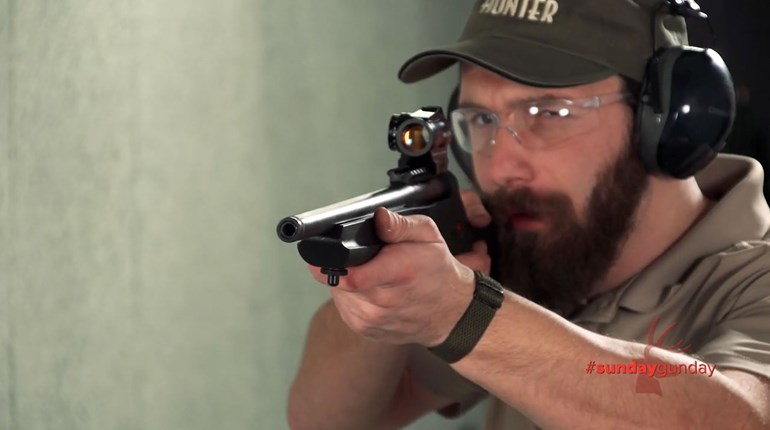
In hunting there are the rifles you choose to make sure you take an animal humanely; and then, there are the rifles you choose to make sure the animal doesn’t take you. A choice for a black bear rifle lends itself to the latter.
Black bears are predators. They are strong, smart and stealthy, but most importantly, they are built physically and mentally to take the food they need, whether it is warm-blooded or deeply rooted, with as much zest as is required regardless of its prey’s desire to live. As such, an animal’s will—not just its hide thickness and mass—should be considered when deciding on the right rifle.
Long before you decide on what caliber you want to go bear hunting with, you to decide the kind of rifle you want to carry. After all, even a .338 Lapua Mag. does you no good if you can’t get the bullet down range—and on target—when you have to.
Today’s hunters have a wide range of choices, from single-shots like the superb Thompson/Center Encore, lever actions like the built-like-a-Swiss-clock Chiappa 1886 Ridge Runner, bolt-actions like CZ’s built-like-a-tank offerings, Remington’s ageless 7600 pump-action rifles, and even today’s very reliable semi-automatic’s like the Browning BAR.
Some choices in gun designs, I think, are better than others when a clean kill helps get me home in one piece. To me, given the possible unpleasant outcomes to either the black bear or me—or both, of a poorly placed first shot, the need for a fast, well-aimed follow-up shot is a requirement. Alaskan hunter and television reality star Cork Graham agrees.
“I don't trust single shots. I like being able to slide another round into the chamber either with a bolt, semi, pump or lever,” he told me.
His logic, which comes from decades of living in brown bear country, makes perfect sense for black bear country as well. For me, the choice is simple—the last black bear I killed here in Virginia on a spot and stalk in the Shenandoah fell from a trigger pulled on a CZ Safari Select 550 bolt-action rifle. Although a follow-up shot wasn’t necessary, I had a second round loaded, instinctively, before I knew I didn’t need it.
 This brings me to my next point. Regardless of what kind of rifle you choose, make sure you practice using it so much so that shooting it becomes second nature. That doesn’t mean just being able to place three well-aimed rounds in the bull’s-eye at your local gun range. It means being able to work the action, safety and trigger cleanly and repeatedly while putting the bullets precisely where you want them under stress so high that there’s a chance there’s a bigger load in your pants than your rifle. Black bears, which can get as large as 800 pounds, have a way of creating just such a situation. In my experience, the purely mechanical bolt-action, lever-action and pump-action rifle mechanics lend themselves to working well when we mentally don’t. Knowing your rifle well should always be the motto of any hunter, but when you’re hunting critters that can make you late for dinner with one casual swipe of their paw, familiarity with your firearm takes on a much higher sense of urgency.
This brings me to my next point. Regardless of what kind of rifle you choose, make sure you practice using it so much so that shooting it becomes second nature. That doesn’t mean just being able to place three well-aimed rounds in the bull’s-eye at your local gun range. It means being able to work the action, safety and trigger cleanly and repeatedly while putting the bullets precisely where you want them under stress so high that there’s a chance there’s a bigger load in your pants than your rifle. Black bears, which can get as large as 800 pounds, have a way of creating just such a situation. In my experience, the purely mechanical bolt-action, lever-action and pump-action rifle mechanics lend themselves to working well when we mentally don’t. Knowing your rifle well should always be the motto of any hunter, but when you’re hunting critters that can make you late for dinner with one casual swipe of their paw, familiarity with your firearm takes on a much higher sense of urgency.
Optics-wise, there are plenty of riflescopes out there, which would work fine in most bear hunting situations. Your magnification range should be selected based on the terrain you’ll be hunting. However, keep in mind that a safe 400-yard poke with your .300 Win. Mag. may still require a 20-yard follow-up shot, so be sure to have the ability to adjust your field of view as your situation dictates. Seeing as most black bears are indeed black, but almost always low to the ground and slow to move, I’d recommend investing in the finer quality optics, which have excellent contrast, so you can separate the bear from the background. Meopta offers some of the finest contrast for optics priced under $1,000 but companies like Leupold, Bushnell, Nikon, Zeiss, Vortex and Kahles all offer great choices. The logic, which holds true for your riflescopes, should be applied to your binoculars and spotting scopes, too.
Now, at some point you’ll have to pick a caliber for your black bear rifle. The good news is there are lots of terrific choices, especially when one considers the remarkable technology available to us by today’s bullet manufacturers like Nosler, Hornady and Sierra. Many folks might think a good deer rifle caliber makes a good black bear choice, and if that advice comes from a hunter who knows his or her rifle and its limitations then it is most certainly true especially if that caliber choice is paired with a proper bullet.
My first black bear fell to the bark of a Howa 1500 bolt-action rifle chambered in the short-action 7mm-08 loaded with 154-grain Hornady Interlock bullets paired with a Leupold 2.5-8x36mm VXIII optic. That CZ 550 Safari Select I mentioned earlier from my Virginia mountains spot and stalk packed a bit more punch with a 180 grain Hornady Interbond bullet from the legendary .300 H&H using a Nikon Monarch 7 2.5-10x50mm optic. I had absolutely no problem seeing the bears through either optic and both gave me clear, defined target images in low light situations. During a spring bear hunt last year in Idaho, the Vortex Viper HD riflescope and binoculars worked hard during a two-hour stalk on a black bear I spotted on the next mountain. I eventually coaxed the bear well within range using a dying rabbit call, but lost the race with legal shooting light when it hung up in the timber stand just 50 yards in front of me.
Alaskan guide and brown bear hunting guru, Phil Shoemaker, thinks very highly of the .300 H&H despite its gray hair. “The .300 H&H is a fantastic caliber that is useful for virtually anything in the world with the bullet technology we have today,” he said. During the same conversation about black bear caliber choices, he gave me some good advice regarding what to feed my 300 H&H. “You can find a lot of written information on the .300 (H&H) and your idea of 180 to 200 grain bullets is correct,” he said. “My favorite is the 200-grain Nosler Partition as it works on everything from whitetails to brown bears in this continent and most game in Africa as well. It also is a great long-range bullet. I've used them in my .30-06 for over 30 years. In fact with modern powders the .30-06 gets higher velocities than the original .300 H&H, but with the same powders the .300 H&H is even better.”
In short, your choice in a black bear rifle caliber ought to begin with the biggest caliber you shoot exceptionally well. Why? “Bears are hard to kill,” Graham reminds us. “They're also much harder to track if the don't offer a good blood trail.” With that logic, Graham gave some solid advice for black bear caliber choices: “I wouldn't shoot a black bear at a range farther than 50 yards with a .30-30,” he said. “I have no problems dropping a bear with a .270 with a 130-grain bullet. My favorite caliber is a .280 Rem in a 140-grain or 150-grain Trophy Bonded Bear Claw bullet.”
Regardless of the caliber you choose, a well-constructed bullet, which offers both good penetration and reliable expansion, will make your caliber choice seem sensible. My point here is this: match your rifle to a caliber, and then your caliber to a bullet based on its intended game and your personal range limit. If you do these things, your weapon will do what it ought to do, if you give it the chance.






































